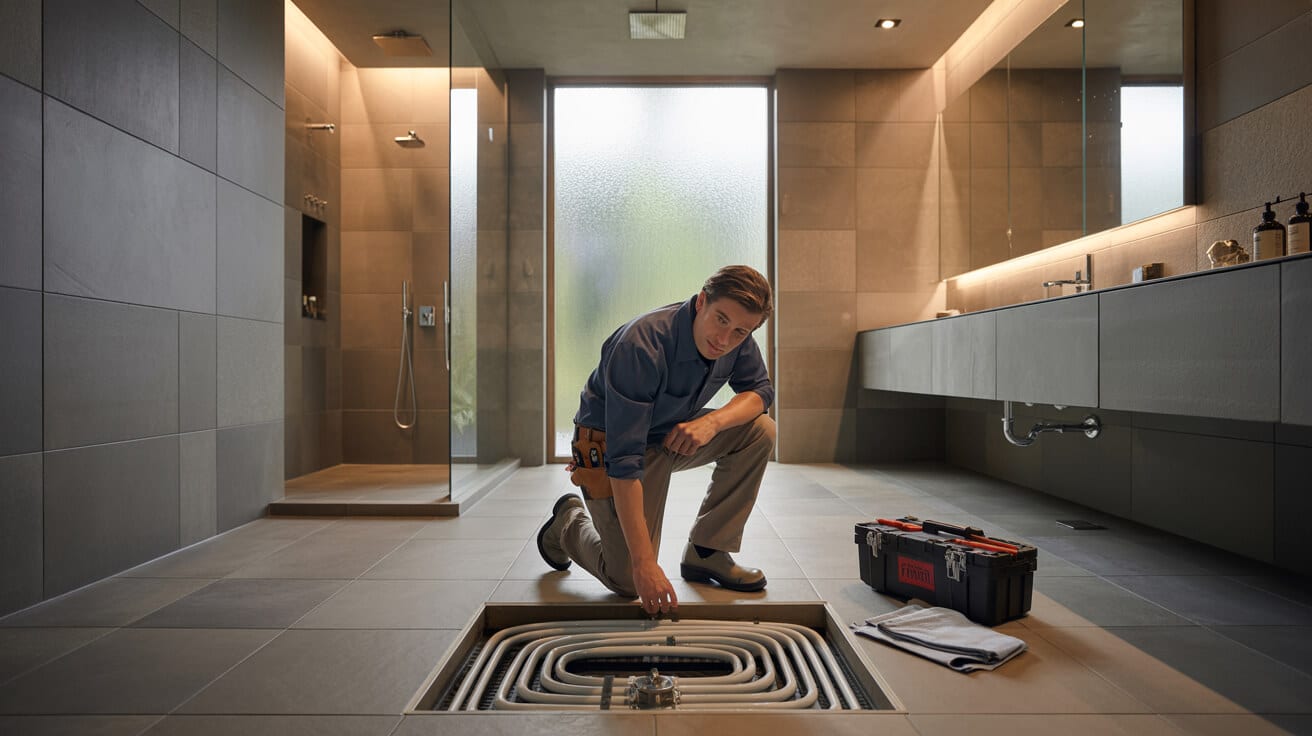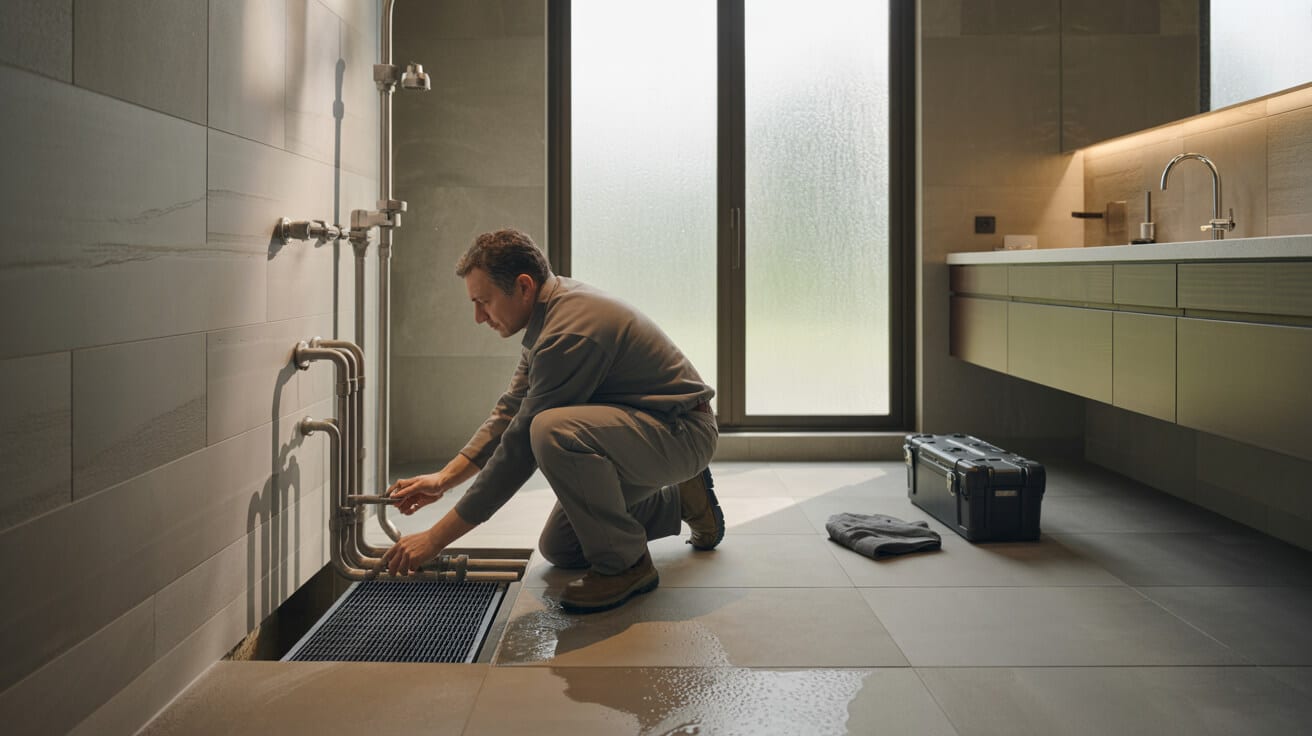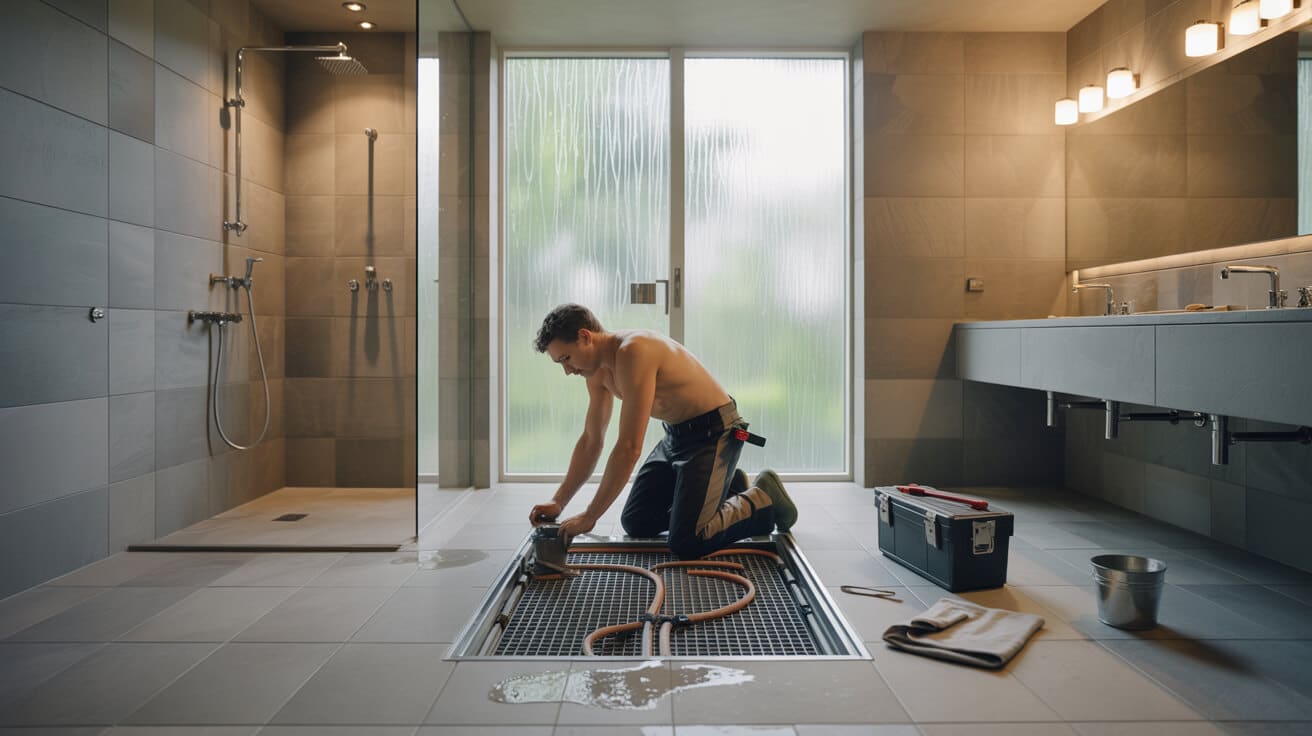Hydronic underfloor heating offers consistent warmth and improved energy efficiency by circulating warm water through a network of embedded pipes. When air becomes trapped, often during installation, routine maintenance, or following component repairs or water ingress, it can interrupt water flow. This manifests as cold spots, noisy operation, and inefficient heating in affected rooms or zones. Property owners, landlords, and facilities managers often rely on experienced technicians to pinpoint, document, and resolve these issues, restoring comfort and safeguarding system value.
Etymology or name origin
The term “airlock” is derived from engineering and physical sciences, where it describes a section of pipe or channel in which trapped air blocks the movement of liquid. In the context of underfloor heating, the term denotes a failure mode specific to closed-loop water systems, reflecting deep roots in both hydraulic design and maintenance terminology.
Overview and context
System description
Underfloor heating (UFH) systems use radiant heat emission from pipes or cables beneath floors to create even warmth across spaces. In water-based systems, a central pump circulates warm water from a heat source through a manifold, distributing flow into several closed loops made of flexible pipework.
Causes of impaired circulation
- Incomplete filling of pipes upon initial installation or after repairs can trap residual air.
- Poor or incorrect bleeding protocols may leave pockets of air stranded, particularly at high points or in complex multi-zone layouts.
- Pipework routed with excessive elevation changes and insufficient gradient promotes air collection.
- Leaks or the slow ingress of air through fitting seals during system depressurization can introduce additional air over time.
Role of plumbing and heating companies
Plumbing and heating companies are responsible for the lifespan care of UFH, from commissioning and installation to annual maintenance and emergency diagnostic work. In properties where the technical demands, regulatory environment, or system design exceed DIY capabilities, these companies deploy certified engineers to resolve performance issues efficiently and record compliance for future warranty or asset management.
Implications for occupants and asset managers
For homeowners, unresolved airlocks directly reduce the value and comfort of property investment, while tenants experience dissatisfaction and demand prompt repair. Facilities managers and landlords have a duty to provide reliable background heating and may also face contractual or statutory obligations. A persistent airlock, if left unaddressed, can translate into increased operating costs, higher rates of system wear, and—occasionally—regulatory penalty.
Relevant standards and best practice
Regulatory codes in the United Kingdom, including Part L of the Building Regulations and WRAS certification, set benchmarks for proper installation, repairs, and water quality management. Emphasising the importance of traceability and documentation, companies like Plumbers 4U maintain comprehensive service records and adhere to both national and manufacturer-specific guidelines.
History
Origins and early systems
Ancient radiant floor systems, such as the Roman hypocaust and Korean ondol, relied on basic hydrodynamics and natural convection but lacked the closed pressurised loops of modern systems, making air ingress far less consequential. Later European developments in the twentieth century, particularly as pressurised boilers and embedded pipes became common, revealed the prevalence and disruptive impact of airlocks.
Advances in heating hydraulics
Postwar adoption of central heating in homes and public buildings increased demand for more complex underfloor systems, exposing new design vulnerabilities. The introduction of manifold systems enabled zonal control but required precise filling and bleeding routines. Advances in pump design, including variable-speed and self-venting pumps, improved resilience, while the standardisation of pipework materials and diameters allowed more consistent installation practices.
Introduction of regulatory frameworks
By the late twentieth century, the introduction of the Water Supply (Water Fittings) Regulations 1999 and Building Regulations parts G & L set new standards. These included requirements for accessible bleed points, manufacturer-certified materials, and documentation to satisfy both compliance inspectors and insurance providers.
Current practices
Current best practices emphasise pre-commissioning system flushing, staged loop filling under moderate pressure, autoventing at manifold and high-point valves, and the use of electronic diagnostics. Service records, pressure logging, and use of magnetic and particulate philtres further protect the system lifecycle.

Concept and technical description
Air movement in closed systems
Fluid dynamics dictates that gases rise to the highest points within a closed hydraulic system. When air becomes trapped, it effectively blocks flow within loops or manifolds, causing sections of floor to remain unheated. The physical density difference between water and air results in displaced or stagnant water in those affected areas.
UFH network topology
A typical UFH installation centres on a manifold, which distributes water to a series of parallel loops. The number of loops, their length, and the floor’s physical gradient all influence where air may be trapped. Multi-zone systems, present in larger homes and many commercial installations, introduce additional complexity and risk of uneven filling and air entrapment.
Key affected components
- Bleed valves: Located at the manifold and occasionally at isolated high points; allow controlled release of air.
- Circulation pumps: Ensure even flow across the system but are vulnerable to cavitation and reduced output when operating with air present.
- Flow metres: Installed on distribution manifolds to quantify flow through each loop; offer a direct visualisation of impaired function.
- Isolation valves and actuators: Enable loop control for staged filling, bleeding, and diagnosis.
Diagnostic criteria
Diagnosis of an airlock employs:
- Observation of cold floor patches with an otherwise operational system.
- Comparison of target and actual flow readings.
- Detection of noise or rapid cycling in the circulation pump.
- Visual inspection for visible bubbles at bleed valves when opened.
- Use of infrared thermography to locate stagnant water.
Comparisons: radiators vs UFH
While both radiators and UFH systems are susceptible to airlocks, traditional radiators provide direct manual bleeding at each emitter, resulting in simpler maintenance. In contrast, UFH systems bury pipework beneath floors, making direct intervention impossible and centralising the task at the manifold or accessible bleed points.
Functionality and practical applications
Common symptoms
Symptoms experienced by users or reported by tenants often include:
- Areas of the floor remaining cold after the heating is active.
- Audible gurgling or sloshing noises from pipework or within the floor.
- Persistent system pressure loss or pump cavitation.
- Failure of affected zones to respond to thermostat adjustments.
Inspection and diagnosis
Your company, or Plumbers 4U, typically undertakes a stepwise procedure: 1. Collect and analyse the pattern of user complaints and system data. 2. Confirm heating source and circulation pump operation. 3. Perform a visual check of all accessible manifolds and flow metres. 4. Sequentially isolate and test loops for restored flow. 5. Use specialised equipment, including infrared cameras or electronic flow sensors, as required.
Stepwise remediation
Diagnostic and repair workflow
| Step | Task | Description |
|---|---|---|
| 1 | System power-down | Ensure safe access and prevent additional circulation during bleed procedure. |
| 2 | Loop isolation | Shut off unaffected loops to target the suspected airlock zone. |
| 3 | Bleed valve opening | Allow air to escape as water is introduced via controlled filling or system pressure. |
| 4 | Sequential flushing | Use proprietary or manual flushing kits to remove persistent air. |
| 5 | System re-pressurisation | Restore to manufacturer-specified values to avoid further ingress. |
| 6 | Confirmation | Observe flow metres and use thermal imaging to verify problem resolution. |
| 7 | Documentation | Record intervention in service and warranty logs. |
Preventive maintenance
- Annual system service, including pressure checks and visual inspection of visible manifolds and fittings.
- Scheduled cleaning or replacement of magnetic particulate philtres.
- Confirmation of autovent operation, often overlooked on older or retrofitted installations.
- Education of property managers or staff to monitor for early warning signs.
Special considerations (commercial, older builds, smart thermostats)
Multi-occupancy premises, large office floors, and properties with intermediary plates/splitters require careful, zone-by-zone diagnosis. smart thermostats, when properly integrated, can alert facilities staff before occupant complaints escalate, providing valuable time for intervention. Older buildings might lack adequate bleed points and may require engineered retrofits to bring installations up to standard.
Classifications / types / variants
Types of underfloor heating systems
- Screed-based systems: Common in new construction, risk of deep airlocks hidden by solid floor layers.
- Low-profile overlay systems: Used for retrofit and renovation projects; compatibility with legacy pipe layouts introduces other risks.
- Multi-zone commercial systems: Additional manifolds, longer runs, and sophisticated control demand enhanced commissioning and service protocols.
- Single-loop domestic systems: Simpler in layout but still subject to air issues if draining, refilling, or extending the circuit.
- Electric systems: Not subject to airlocks but may be present alongside hydronic loops in hybrid installations.
Airlock risk comparison by variant
| System Type | Airlock Risk | Typical Mitigation |
|---|---|---|
| Screed-based hydronic | High | Advanced flushing, autovents |
| Overlay low-profile | Moderate | Isolated bleeding, careful layout |
| Multi-zone commercial | High | Multi-stage bleed, digital monitoring |
| Single-zone domestic | Moderate | Manual bleed sufficient |
| Electric (cables) | None | N/A |
Systems, tools, and methodologies
Standard tools and equipment
- Manual tools: Bleed keys (specific to manifold make), adjustable HP filling devices, pressure test gauges.
- Powered systems: Dual-head flushing pumps, electronic leak and flow detectors, dedicated purge stations for large/commercial sites.
- Diagnostic aids: Thermal imaging cameras, sound-detection probes, smart app integration (where installed) for real-time monitoring.
Manual vs powered methodologies
- Manually bleeding a loop is effective for small, isolated issues or recent installations.
- Powered jetting and reverse-cycling devices are required in larger or persistent airlocks, multi-zone buildings, or where pipe length/resistance impedes manual draining.
Manufacturer and industry guidelines
Manufacturers such as Uponor, Nu-Heat, John Guest, and Plumbers 4U issue bespoke commissioning instructions for new and renovated systems. Adherence is necessary for warranty compliance and ongoing system support.
Warranty and compliance records
Forward-thinking companies maintain digital and hardcopy logs of all interventions, bleeding, and flushing events. These records are essential for your insurance claims, compliance inspection, and resale valuation of the property.

Stakeholders and entities involved
Homeowners and tenants
In both owner-occupied and rented homes, end-users have a direct experience of comfort, potentially facing service interruptions or unscheduled repair costs. Knowledge transfer from service firms aids early detection and rapid reporting.
Landlords and letting agents
Subject to various statutory requirements regarding habitability, landlords must ensure prompt heating system repairs. letting agents typically organise qualified intervention, oversee warranty compliance, and mediate between tenants and service providers.
Facilities managers
Responsible for building-wide system operation, facilities managers benefit from structured service contracts, asset monitoring, and scheduling preventive maintenance—managed collaboratively with trusted companies, including brands like Plumbers 4U.
Installers and service companies
Accredited, trained engineers with sector credentials (e.g., WRAS, G3, CIPHE membership) execute both routine and advanced repair, supply compliance-worth documentation, and provide client education as part of a holistic service relationship.
Regulatory and oversight bodies
Building control, water authority inspectors, insurers, and trade associations contribute to the regulatory landscape. Their oversight influences standards, reporting, and qualification requirements at every intervention stage.
Legal, regulatory, and ethical considerations
Building regulations and bylaws
UK Part L governs efficiency and system operation, while WRAS rules ensure water fittings and protocols maintain potable water quality and safety. G3 certification is required for certain systems, especially unvented hot water.
Certification and qualification
Bleeding, flushing, or replacing system components should be handled by a WRAS and (where needed) G3-certified engineer. This is vital for insurance and compliance and ensures that your property or organisation remains protected.
Insurance and warranty conditions
Inadequate recordkeeping, unqualified interventions, or use of non-approved parts can jeopardise your insurance coverage and void system warranties. Reputable firms, such as Plumbers 4U, integrate compliance-driven logging to safeguard all parties and ensure transparent asset stewardship.
Duty of care and client communication
Professional standards mandate engineers to explain risks, safety factors, service limits, and costs transparently. Trust grows from clarity and from the assurance that interventions comply with sector, regulatory, and property-level norms.
Performance metrics, data, and measurements
Service and repair benchmarks
| Metric | Typical Value |
|---|---|
| Average time to diagnose | 45–90 minutes |
| Average fix duration | 1–3 hours |
| Recurrence rate | <5% (when serviced properly) |
| Preventive maintenance | Annual or biannual advisable |
| Documentation compliance | 100% for insurance coverage |
System performance validation
After repairs and maintenance:
- Verify even heat distribution via infrared imaging or manual checks.
- Confirm system pressure within manufacturer range.
- Log flow rates for each loop using integrated or attachable metres.
- Update maintenance and compliance logs.
Challenges, barriers, and limitations
Technical and operational barriers
- Access to manifold boxes or loop ends may be obstructed by furniture, finishes, or lack of as-built system data.
- Legacy piping, hybridised with radiator circuits, complicates valve mapping.
- Ad hoc DIY solutions including improper valve use can mask underlying airlocks or escalate faults.
Social and economic factors
- Cost concerns may delay regular servicing, resulting in preventable system failures.
- Occupant expectations, especially in rental or managed buildings, can clash with repair scheduling or downtime needs.
- Within commercial property, balancing energy savings targets with comfort may influence system intervention intervals.
Edge cases and rare installations
- Heritage or ultra-modern properties may have systems deviating from contemporary best practice, lacking sufficient bleed or monitoring points.
- Imported componentry and control software require specialist knowledge and bespoke documentation.
Impact, relevance, and legacy
Properly maintained underfloor heating yields measurable benefits: reduced energy expenditure, improved indoor air quality (due to lower convective currents), and enhanced capital value for your properties. Reliable intervention builds trust between you, your tenants, and your contracted service company. Transparent reporting, adherence to technical and regulatory norms, and a focus on preventive maintenance all contribute to your property’s operational resilience and market standing. Industry leaders, including Plumbers 4U, drive these gains through professionalism and rigorous process control.
Future directions, cultural relevance, and design discourse
Incremental advances in heating automation, algorithmic system diagnostics, and self-balancing hydronic controls are expected to continue. The sector is seeing a move toward modular servicing, digital compliance archiving, and the adoption of self-purging valves—reducing the frequency and impact of airlocks. Increased occupant and asset-management awareness places pressure on companies to supply not just technical fixes, but educational and strategic advice contextually tailored to your building type and usage patterns. Cultural shifts toward energy efficiency, tenant rights, and building ecosystem intelligence reinforce the value of professional partnership and proactive system stewardship.

